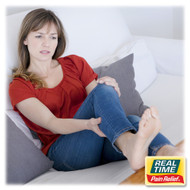6 Tips to Reduce Restless Leg Syndrome
28th Jul 2023
Dealing with Restless Leg Syndrome? You are not alone! We have found some tips to help you experience relief.
Restless leg syndrome (RLS) is a nervous system disorder that causes uncomfortable sensations in the legs. The sensation can vary depending on the person and creates an overwhelming need to move the legs. Some of the different ways people describe the feeling include:
- throbbing
- achiness
- pain
- numbness
- tingling sensations
- creeping feeling as though insects are moving across your skin
For most people with RLS, the condition is at its worst in the evening, especially when your body is at rest. Because it commonly strikes at night, RLS can also cause sleeplessness, therefore it is also classified as a sleep disorder.
Risk Factors of Restless Leg Syndrome
With most cases of restless leg syndrome, the cause is unknown. Risk factors include:
- side effects of medications
- iron deficiency
- lifestyle and dietary choices
- health conditions like Parkinson's disease, kidney failure, diabetes, and peripheral neuropathy.
- certain genetic component leading to RLS
Who is at Risk?
It is estimated that up to 10% of Americans suffer from restless leg syndrome and that about 2-3% of these cases are categorized as severe RLS. It can affect people of all ages, but is most common in middle-aged and older individuals.
Treatment Options for Restless Leg Syndrome
Once diagnosed with restless leg syndrome, it is usually possible to manage the symptoms. While doctors may prescribe various medications to help treat restless leg syndrome, there are some alternative ways to find relief.
*It is best to talk to your doctor before starting a new routine.
6 Tips to Get Relief for Restless Leg Syndrome
#1) Massage
Because restless leg syndrome causes pain and tension in the muscles, a massage is considered to be an effective way to find relief. A massage can improve blood flow, help ease aches, and relax tight muscles. A regular appointment with a licensed massage therapist may help to prevent future attacks. However, massaging your own legs, or asking a loved one to help, can also be beneficial during an attack.
For an extra boost during your massage, try applying a menthol-based topical pain relief lotion to your legs. Other great ingredients to look for in a topical analgesic include capsicum, arnica, and willow bark.
#2) Hot and Cold Therapy
Hot and cold therapy can help to reduce tension and inflammation in the muscles. Alternating between hot and cold packs is a great way to distract your mind from the uncomfortable sensations produced by restless leg syndrome.
Some people find that taking a hot shower is beneficial. Also spending time in a sauna may also help reduce symptoms of Restless Leg Syndrome.
#3) Take a Warm Bath
A warm bath helps increase blood circulation and loosen tight muscles. Adding a bath bomb infused with Arnica to your bath may help with muscle pain, stiffness, and bruising. Other great ingredients include Epsom salt, willow bark, and chamomile.
#4) Gentle Exercise
Regular gentle exercise improves the health of your nervous system, improves blood flow, and works out the leg muscles. Do activities, such as walking, water aerobics, and yoga. Ask your doctor about what type of exercises are best for your situation. A physical therapist is also a good resource for specific exercises to ease the pain.
Because RLS is commonly associated with sleep trouble, try to avoid exercising late in the day. It is a good idea to make it a part of your morning routine.
#5) Distract Your Mind
Finding ways to distract your mind from the sensations of restless leg syndrome may help you get some relief. Some ways to do this include alternating between hot and cold packs, relaxation or breathing techniques, exercise, reading, or watching television.
There are a variety of relaxation techniques like meditation and controlled breathing that can help to distract the mind during an RLS attack. Yoga and tai chi can also work wonders.
#6) Supplements
Check with your doctor to learn if you have any nutritional deficiencies that could be causing your Restless leg Syndrome. According to The Journal of Clinical Sleep Medicine, researchers have identified a link between Vitamin D deficiency and Restless Leg Syndrome.
Researchers have also found a link to iron deficiency and Restless Leg Syndrome.
Restless Leg Syndrome can also be caused by deficiencies in various B vitamins and magnesium. If you are deficient in any of these nutrients, adjustments to your diet could help, but you may need to take regular supplements.
Talk to your doctor to learn more about beneficial supplements that you may need to consider to help manage the symptoms. And try to eat plenty of foods rich in these nutrients.
Things to Avoid With Restless Leg Syndrome
Restless leg syndrome will affect each person differently. The painful sensations can be different for each person, as well as the frequency and severity of the attacks. Regardless of your specific problems with RLS, there are some things that you should avoid.
- Avoid sitting in the same position for long periods of time.
- Avoid caffeine drinks like coffee, tea, and soda. It is especially important to avoid these drinks in the evening or close to bedtime.
- Avoid tobacco and alcohol. Regular consumption of alcohol or tobacco can contribute to problems with restless leg syndrome.
- Avoid eating too many sweets, fried foods, and processed foods.





